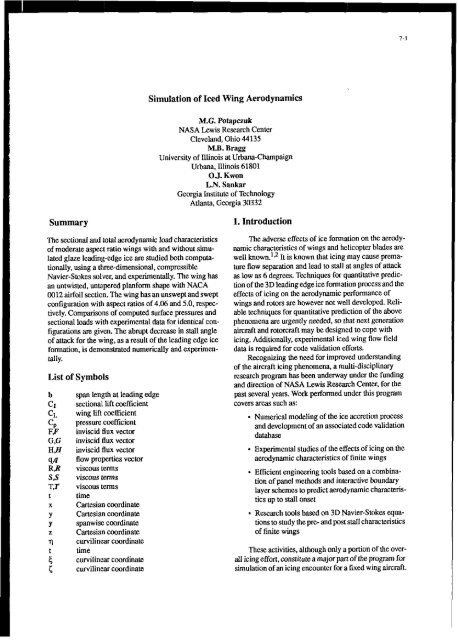Create successful ePaper yourself
Turn your PDF publications into a flip-book with our unique Google optimized e-Paper software.
Simulation of Iced Wing Aerodynamics<br />
M.G. Potapczuk<br />
NASA Lewis Research Center<br />
Cleveland, Ohio 44135<br />
M.B. Bragg<br />
University of Illinois at Urbana-Champaign<br />
Urbana, Illinois 61801<br />
0 J. Kwnn<br />
L.N. Sankar<br />
Georgia Institute of Technology<br />
Atlanta, Georgia 30332<br />
Summary 1. Introduction<br />
The sectional and total aerodynamic load characteristics<br />
of moderate aspect ratio wings with and without simu-<br />
lated glaze leading-edge ice are studied both computa-<br />
tionally, using a three-dimensional, compressible<br />
Navier-Stokes solver, and experimentally. The wing has<br />
an untwisted, untzlpered planform shape with NACA<br />
0012 airfoil section. The wing has an unswept and swept<br />
configuration with aspect ratios of 4.06 and 5.0, respec-<br />
tively. Comparisons of computed surface pressures and<br />
sectional loads with experimental data for identical con-<br />
figurations are given. The abrupt decrease in stall angle<br />
of attack for the wing, as a result of the leading edge ice<br />
formation, is demonstrated numerically and experimen-<br />
tally.<br />
List of Symbols<br />
span length at leading edge<br />
sectional lift coefficient<br />
wing lift coetficient<br />
pressure coefficient<br />
inviscid flux vector<br />
inviscid flux vector<br />
inviscid flux vector<br />
flow properties vector<br />
viscous terms<br />
viscous terms<br />
viscous terms<br />
time<br />
Cartesian coordinate<br />
Cartesian coordinate<br />
spanwise coordinate<br />
Cartesia,n coordinate<br />
curvilinear coordinate<br />
time<br />
curvilinear coordinate<br />
curvilinear coordinate<br />
7-1<br />
The adverse effects of ice formation on the aerodynamic<br />
characteristics of wings and helicopter blades are<br />
well known.'J It is known that icing may cause premature<br />
flow separation and lead to stall at angles of atrack<br />
as low as 6 degrees. Techniques for quantitative prediction<br />
of the 3D leading edge ice formation pracess and the<br />
effects of icing on the aerodynamic performance of<br />
wings and rotors are however not well developed. Reliable<br />
techniques for quantitative prediction of the above<br />
phenomena are urgently needed, so that next generation<br />
aircraft and rotorcraft may be designed to cope with<br />
icing. Additionally, experimental iced wing flow field<br />
data is required for code validation effom.<br />
Recognizing the need for improved undersfanding<br />
of the aircraft icing phenomena, a multi-disciplinary<br />
research program has been underway under the funding<br />
and direction of NASA Lewis Research Center, for the<br />
past several years. Work performed under this program<br />
covers areas such as:<br />
Numerical modeling of the ice accretion process<br />
and development of an associated code validation<br />
database<br />
- Experimental studies of the effects of icing on the<br />
aerodynamic characteristics of finite wings<br />
- Efficient engineering tools based on a combina-<br />
tion of panel methods and interactive boundary<br />
layer schemes to predict aerodynamic characteris-<br />
tics up to stall onset<br />
Research tools based on 3D Navier-Stokes equa-<br />
tions to study the pre- and post stall characteristics<br />
of finite wings<br />
These activities, although only a portion of the over-<br />
all icing effort, constitute a majorpart of the program for<br />
simulation of an icing encounter for a fixed wing aircraft.

















